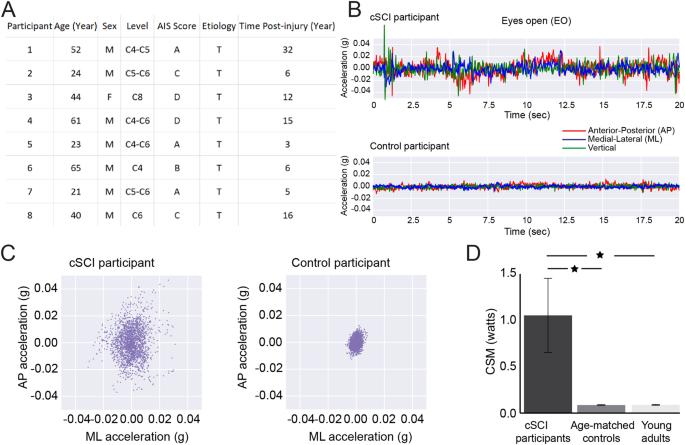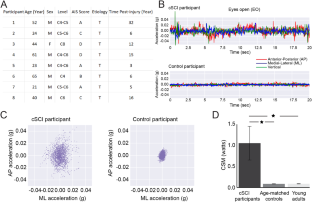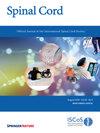Quantifying unsupported sitting posture impairments in humans with cervical spinal cord injury using a head-mounted IMU sensor
IF 2.2
4区 医学
Q3 CLINICAL NEUROLOGY
引用次数: 0
Abstract
Cross-sectional study. To evaluate unsupported sitting posture impairments and identify postural regulatory strategies in cervical spinal cord injury (cSCI) participants via a head-mounted IMU sensor. A research lab in the United States of America. cSCI participants and controls maintained postural stability during unsupported sitting with eyes either open or closed. The head-mounted IMU sensor recorded accelerometer data to calculate cumulative sway motion. The postural regulatory strategy was analyzed by assessing the normalized power spectral density (PSD) in four frequency bands: 0–0.1 Hz (visual regulation), 0.1–0.5 Hz (vestibular regulation), 0.5–1 Hz (cerebellar regulation), and >1 Hz (proprioception and muscle control). Significant increases in postural sway were observed in cSCI participants compared to controls during unsupported sitting. For cSCI participants, normalized PSD significantly increased in the low-frequency bands (0–0.1 Hz and 0.1–0.5 Hz) but decreased in the high-frequency band (>1 Hz) compared to controls. cSCI participants were more reliant on visual and vestibular systems for sitting balance, while depending less on proprioception and muscle control compared to controls. These findings suggest that the altered postural regulatory strategy is ineffective in maintaining postural stability during unsupported sitting, emphasizing the importance of proprioception and muscle control for seated postural stability in cSCI participants.


使用头戴式 IMU 传感器量化颈椎损伤患者的无支撑坐姿损伤
研究设计横断面研究目的通过头戴式 IMU 传感器评估颈椎脊髓损伤(cSCI)参与者无支撑坐姿障碍并确定姿势调节策略设置美国的一个研究实验室方法颈椎脊髓损伤(cSCI)参与者和对照组在睁眼或闭眼的无支撑坐姿期间保持姿势稳定。头戴式 IMU 传感器记录加速度计数据以计算累计摇摆运动。通过评估四个频段的归一化功率谱密度(PSD)来分析姿势调节策略:结果与对照组相比,观察到 cSCI 参与者在无支撑坐姿时的姿势摇摆显著增加。与对照组相比,cSCI 参与者在低频段(0-0.1 Hz 和 0.1-0.5 Hz)的归一化 PSD 显著增加,但在高频段(1 Hz)则有所减少。这些研究结果表明,改变后的姿势调节策略无法有效维持无支撑坐姿时的姿势稳定性,从而强调了本体感觉和肌肉控制对 cSCI 参与者坐姿稳定性的重要性。
本文章由计算机程序翻译,如有差异,请以英文原文为准。
求助全文
约1分钟内获得全文
求助全文
来源期刊

Spinal cord
医学-临床神经学
CiteScore
4.50
自引率
9.10%
发文量
142
审稿时长
2 months
期刊介绍:
Spinal Cord is a specialised, international journal that has been publishing spinal cord related manuscripts since 1963. It appears monthly, online and in print, and accepts contributions on spinal cord anatomy, physiology, management of injury and disease, and the quality of life and life circumstances of people with a spinal cord injury. Spinal Cord is multi-disciplinary and publishes contributions across the entire spectrum of research ranging from basic science to applied clinical research. It focuses on high quality original research, systematic reviews and narrative reviews.
Spinal Cord''s sister journal Spinal Cord Series and Cases: Clinical Management in Spinal Cord Disorders publishes high quality case reports, small case series, pilot and retrospective studies perspectives, Pulse survey articles, Point-couterpoint articles, correspondences and book reviews. It specialises in material that addresses all aspects of life for persons with spinal cord injuries or disorders. For more information, please see the aims and scope of Spinal Cord Series and Cases.
 求助内容:
求助内容: 应助结果提醒方式:
应助结果提醒方式:


